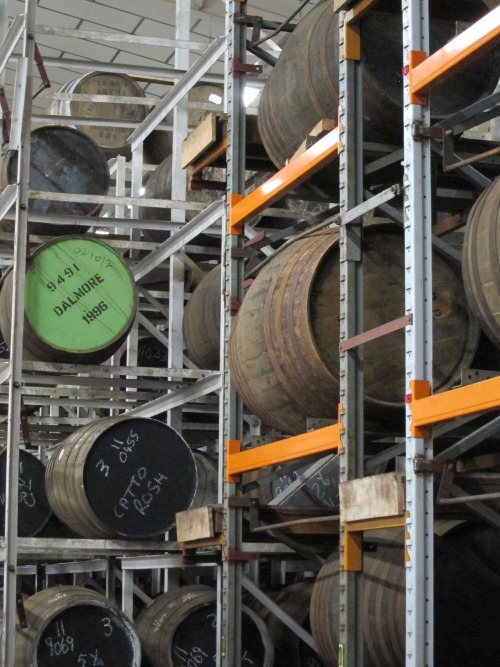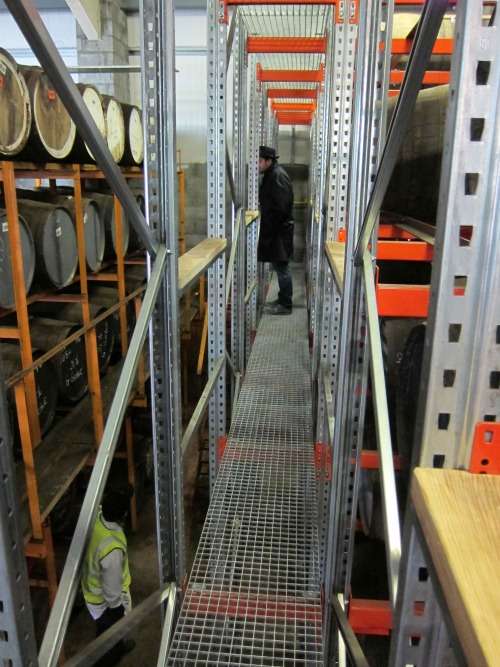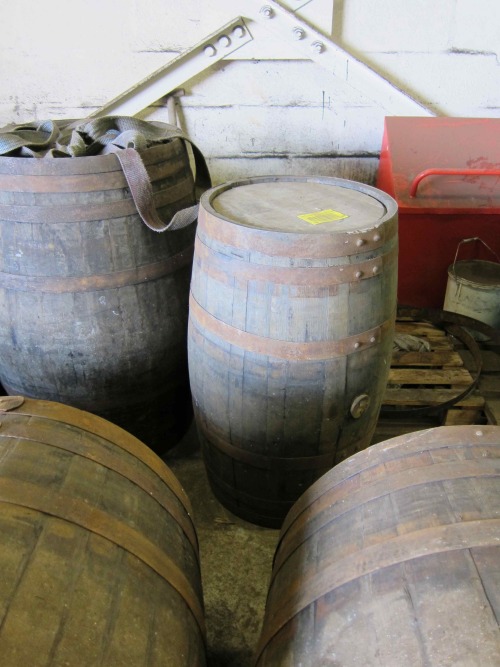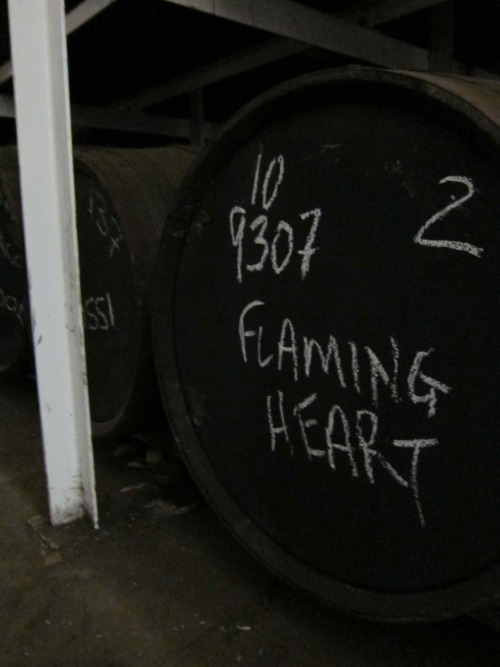Scotland - Day Two - Macleod/Chieftain's continued
 The many-tiered racks at the Chieftain's warehouse
The many-tiered racks at the Chieftain's warehouse
After a long night's sleep and a proper breakfast at our hotel this morning, David OG and I headed back over to the Ian Mcleod facility for some more tasting and whisky education. While I've visited a few distilleries in the U.S. with their own warehouse of barrels, I've never before visited a warehouse full of various whiskies from different distilleries. Chieftain's not only houses their own casks, but also barrels for companies like Diageo and Compass Box, which meant we saw names of whiskies like Lagavulin or Flaming Heart intermingled with their own stocks. John met us at the office a little after nine A.M. and we proceeded with our tour of the warehouse and the Broxburn bottling facility.
 David OG talks to John below about a few casks
David OG talks to John below about a few casks
While a distillery is where the magic of making whisky happens, a warehouse like Chieftain's is where the magic of tasting whisky happens. Sure you could walk through the Ardbeg warehouse and maybe you'd be lucky enough to taste some casks of various ages, but they'd all be from Ardbeg. Chieftain's is sitting on a goldmine of mature whiskies of various ages and John was more than happy to bust a few bung holes open for us. David and I couldn't help but notice the barrage of prestigious distillery names on the sides of the barrels and we were very curious as to how they were able to acquire them. John explained that while it was nice to have such exclusive whiskies, they could never be bottled as single cask malts because the distilleries only sell them the barrels on that one condition. In order to ensure that their products are never sold as single malts bearing their name, they do what is known as teaspooning, which means they add a teaspoon of another whisky into the barrel. It does absolutely nothing to effect the flavor, but it immediately renders the whisky a vatted malt rather than a single malt and eliminates the possibility. For example, Macallan might add a teaspoon of Glenrothes to ensure that Chieftain's doesn't capitalize on their single malt trademark.
 The oft-mentioned "quarter cask" (i.e. Laphroaig, Ardmore) which was much larger than I expected
The oft-mentioned "quarter cask" (i.e. Laphroaig, Ardmore) which was much larger than I expected
Besides bottling single cask whiskies under Chieftain's, the Ian Macleod company uses their prestigious acquisitions for their own blending projects i.e. Smokehead, Isle of Skye, etc. They do not reveal the whiskies in the blend, but after visiting their facility I have a good idea of what could be inside. For example, I always thought that all peated Islay blends had to be a majority of Caol Ila or Laphroaig because those are the two easiest distilleries to source casks from, but I know now that if it comes from Macleod it could literally be anything. In fact, if you DON'T see the distillery name on the bottle I think there's a better chance that is something very interesting! I mentioned in yesterday's post that they have a professional relationship with just about everyone, including Diageo, because they are loyal to their word that they will never reveal the distillery's name when they agree not to, not even to insiders like us. That means they get loads of good stuff and that good stuff goes into blends like Isle of Skye.
 David OG holds a fine glass of Invergordon single grain whisky
David OG holds a fine glass of Invergordon single grain whisky
Speaking of blends, David and I asked John how he felt about the derogatory association that accompanies blended whiskies and, like us, he was a bit surprised that so many people would pass on some incredible values simply because of the presence of grain alcohol. He was quick to remind us that not all grain alcohol is created equally and some grain whiskies are absolutely fantastic on their own. No sooner did we start discussing the subject when we stumbled upon a 23 year old cask of Invergordon, and John was of course happy to break it open for us. The whisky was from a sherry butt and therefore dark and rich with caramel aromas. The flavors were rich and well-balanced. While being perhaps a bit one-dimensional, I would challenge any whisky snob out there to turn down their nose at such a dram. I would be ecstatic if a whisky like the Invergordon could be the basis of a tasty blend we could purchase for K&L.
 One of John Glaser's barrels hiding out in the facility
One of John Glaser's barrels hiding out in the facility
Blends have always been a contraversal subject for whisky fans and I won't use this article to spark that debate once more, but guys like John Glaser have been sourcing some serious grain whiskies that are delicious for projects like the Double Single and the Hedonism that have helped to rejuvenate interest. John's barrels would pop up around the warehouse from time to time, so if you're reading this John, how about you let us buy a single barrel of Flaming Heart? I know you have one because I have the photo to prove it!

The bottling plant next to the warehouse was also quite a treat if only to be able to witness the chill-filtration device. The whisky is chilled down, pumped in through the front here and then the filtration pads in the middle take out an coagulates in the liquid. They use this primarily for the blends only as most Chieftain's customers do not want their malts to be filtered.
All in all it was very educational trip, perhaps even more so than a true distillery because of the lesson in whisky politics we received. Learning how the industry operates is often more interesting and helpful than learning how whisky is made! David and I both thought the world of Roderick and John who are two extremely nice gentlemen that make Macleod and Chieftain's a fantastic operation. I left their place even more impressed than I already had been.
We took the rest of the day to drive around Glasgow and head south on the Campbeltown Peninsula - a 4+ hour trek from Edinburgh. I sit here now in my guesthouse room across the street from my favorite distillery in the world - Springbank. Time for David OG to go have a pint and call it a night. More tomorrow. See you then.
-David Driscoll
